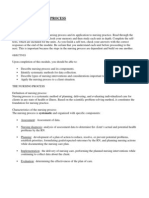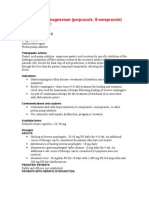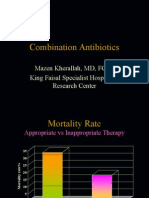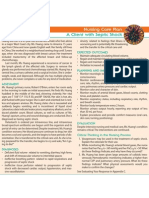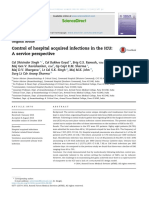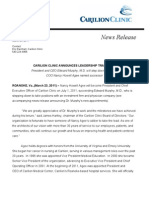Health Assessment
Health Assessment
Uploaded by
Cres Padua QuinzonCopyright:
Available Formats
Health Assessment
Health Assessment
Uploaded by
Cres Padua QuinzonCopyright
Available Formats
Share this document
Did you find this document useful?
Is this content inappropriate?
Copyright:
Available Formats
Health Assessment
Health Assessment
Uploaded by
Cres Padua QuinzonCopyright:
Available Formats
HEALTH ASSESSMENT It is the orderly collection of objective information about the clients health status (objective data are
re observable, measurable, and verifiable by more than one person) It is the foundation of all nursing care (physical assessment is part of every holistic health evaluation.)
ASSESSMENT First and most critical phase of nursing process A complete yet organized assessment is obtained by using a combination of head to toe and body systems approach. The nurse is responsible for assessing the patient for any problems or needs; determining when those findings require the attention of a nurse, physician, or other professional; notifying the appropriate persons of the assessment findings; and ensuring follow up for the patient. Assessment involves the collection of data about the system (individual, family, or community). Data is collected by way of interview, physical examination, research, and review of records. The complete body of information about the patient is called the patient data base At times, it may be necessary to perform a focus assessment instead of a complete assessment. For example, you may be ambulating a patient and he may complain about being constipated. You won't want to collect a complete history and physical at this time because that has already been done. However, you would want to focus on the problem of constipation and find out how long it has been going on, the last bowel movement, the characteristics of the bowel movement, any pain the patient may be having, what factors contributed to the constipation, the client's diet and fluid intake, and his usual treatment for constipation.
PURPOSES Collect subjective and objective data to determine a clients overall level of functioning in order to make a professional clinical judgment. Collect physiologic, psychological, socio- cultural, developmental and spiritual data of the client. Focuses on how the client health status affects his activities of daily living and vise versa.
What is nursing process? Nursing process >A cyclical process that nurses use to identify; analyze; plan; and evaluate the strengths, weaknesses, and needs of the focus system whether it is an individual, family, group, or community. >The nursing process provides a means of applying the knowledge and skills required of nurses >For students, it provides guidance in learning "how to think" like a nurse and applying the magnitude of knowledge gained through classroom education. > For practicing nurses, it provides for a consistent standard of care and communication between colleagues.
PHASES OF NURSING PROCESS Phase I II Title Assessment Diagnosis Description > Collecting subjective and objective data > Analyzing subjective and objective data to make a Professional nursing judgment-nursingnursing diagnosis, Collaborative problem or referral) > Determining outcome criteria and developing a plan. > Carrying out the plan. > Assessing whether outcome criteria have been met and revising the plan as necessary
III IV V
Planning Implementation Evaluation
The Nursing Process involves five steps that correlate with the problem solving method 1. Assessment - The collection of information or data necessary to determine the patient's health status and understand to understand the patient= strengths and problems more clearly. (Gathering the pieces of the puzzle). 2. Diagnosis After gathering the information it is analyzed to identify strengths and actual and potential problems. 3. Planning - A plan of care is developed in cooperation with the patient and significant others. The plan of care is aimed at reducing or eliminating the problems and promoting health. To plan, priorities must be set, expected outcomes must be established, and you must determine what interventions will help achieve the expected outcomes that you have established. You also determine who needs to be involved and how and when the interventions will be done. 4. Implementation - Your plan of care is put into action. During implementation, you assess the patient's current status to see if his/her plan is still appropriate or whether there are new problems. The interventions and activities are then performed and you continue to assess the patient to see of there is any response or whether the intervention made a difference. Finally, you report any data that requires additional treatment, e.g., physician consultation, and record the nursing actions, patient response, and other significant assessment data.
5. Evaluation - During evaluation you and the patient determine whether the plan has worked and whether changes need to be made. Have any new problems developed? Are there new priorities? Have the expected outcomes been achieved? Should new expected outcomes be set? Have the goals been partially met or not at all? Why? Were the goals realistic? Was the assessment accurate? Did other problems get in the way? What changes are you going to make?
FOUR DIVISION OF HEALTH ASSESSMENT 1. 2. 3. 4. Present health history Past health history Family history Lifestyle and health practiced
PHYSICAL ASSESSMENT INCLUDES: 1. Procedure 2. Normal findings of the body system 3. Abnormal findings of the body system Nursing Health assessment result: 1. 2. 3. 4. Formulation of nursing diagnosis (wellness, risk or actual) that require nursing care. Identification of collaborative problems that require nursing care. Identification of collaborative problems that requires interdisciplinary care. Identification of medical problems that require immediate referral.
Types of Assessment 1. 2. 3. 4. Initial comprehensive assessment Ongoing or partial assessment Focus or problem oriented assessment Emergency assessment
1. Initial comprehensive assessment
Involves collection of subjective data about the clients perception of her health of all body parts or systems, past health history, family history and health practices. Involves objective data gathered during step-by-step physical examination. Regardless of who collects the data, total health assessment (subjective and objective data) is needed when the client enters a health care system to establish Baseline data against to which future health status changes can be measured and compared.
You might also like
- TPN Ansap 2Document14 pagesTPN Ansap 2marodessaNo ratings yet
- Peg TubeDocument14 pagesPeg Tubejonisyang100% (1)
- Gibbs Reflective Journal SampleDocument4 pagesGibbs Reflective Journal SampleCres Padua Quinzon100% (3)
- Gibbs Reflective Journal SampleDocument4 pagesGibbs Reflective Journal SampleCres Padua Quinzon100% (3)
- Anger Management Course Workbook PDFDocument29 pagesAnger Management Course Workbook PDFNunu Amal100% (3)
- PEG Insertion - Ethical GuidelinesDocument6 pagesPEG Insertion - Ethical Guidelinesস্বপ্নকথাNo ratings yet
- M1 - Nusing Care ManagementDocument40 pagesM1 - Nusing Care ManagementKristine KimNo ratings yet
- Essay Nursing Process ThohirDocument3 pagesEssay Nursing Process ThohirIlham ThohirNo ratings yet
- POSTPARTUM-scenario2 bsn2dDocument4 pagesPOSTPARTUM-scenario2 bsn2dHannah VillavicencioNo ratings yet
- Health Care Ethics.w1Document10 pagesHealth Care Ethics.w1Roshin TejeroNo ratings yet
- Unit 10 Activity & ExerciseDocument110 pagesUnit 10 Activity & ExerciseAshaNo ratings yet
- Module 3 - Nursing Assessment in Family Nursing PracticeDocument7 pagesModule 3 - Nursing Assessment in Family Nursing PracticeRogedith DelaRosaNo ratings yet
- Pediatric Nursing AssessmentDocument1 pagePediatric Nursing AssessmentsimonedarlingNo ratings yet
- Pediatric NursingDocument17 pagesPediatric NursingMark Ray A. EspinozaNo ratings yet
- MCNDocument4 pagesMCNAijem RyanNo ratings yet
- Informed Consent Form: Where Soul Empowers TechnologyDocument9 pagesInformed Consent Form: Where Soul Empowers TechnologyZg ZernNo ratings yet
- The Nursing Health History (NHH) : NCM 101-A: Health AssessmentDocument7 pagesThe Nursing Health History (NHH) : NCM 101-A: Health Assessmentthe someone100% (1)
- Complete Health AssessmentDocument3 pagesComplete Health AssessmentQueensterNo ratings yet
- Chapter 2 Family Centered Community Based CareDocument2 pagesChapter 2 Family Centered Community Based CareBlake McCabeNo ratings yet
- Nursing ProceduresDocument51 pagesNursing ProceduresLouella Mae CoraldeNo ratings yet
- Revised OxygenationDocument122 pagesRevised OxygenationCHALIE MEQUNo ratings yet
- Nursing Process Unit-4Document27 pagesNursing Process Unit-4Rashid HussainNo ratings yet
- 52389924-IV-therapy NotesDocument57 pages52389924-IV-therapy Notesrye08No ratings yet
- NURS 321/527 Unit 4 Review Digestion: GERD, Malabsorption, Pancreatitis, HepatitisDocument19 pagesNURS 321/527 Unit 4 Review Digestion: GERD, Malabsorption, Pancreatitis, HepatitisSamip PatelNo ratings yet
- NCM 0114 Module 4 Audio PowerpointDocument20 pagesNCM 0114 Module 4 Audio PowerpointKristine KimNo ratings yet
- Pedia NotesDocument57 pagesPedia NotesJoeben L. DisuNo ratings yet
- Rle Eval ToolDocument3 pagesRle Eval ToolArt V. DomingoNo ratings yet
- Catheterization DemoDocument48 pagesCatheterization Demojonna casumpangNo ratings yet
- Final Nursing Skills Check-OffDocument17 pagesFinal Nursing Skills Check-OffWMG 10/10100% (1)
- Top 93 Nursing Skills, Procedures and Normal Values - OkDocument26 pagesTop 93 Nursing Skills, Procedures and Normal Values - OkWilmaBongotanPadawil100% (1)
- Course Syllabus NUPC 112 2021-2022Document6 pagesCourse Syllabus NUPC 112 2021-2022Jeannasly CabotajeNo ratings yet
- Reflective ExemplarDocument2 pagesReflective Exemplarapi-531834240No ratings yet
- MSC Nursing2016-17 PDFDocument576 pagesMSC Nursing2016-17 PDFashi leginNo ratings yet
- Arcega, Romar Rico H. Bsn-Iii NCM 116 1. What Educational Topics Should The Nurse Provide The Family About Home Care For The Patient After Stroke?Document1 pageArcega, Romar Rico H. Bsn-Iii NCM 116 1. What Educational Topics Should The Nurse Provide The Family About Home Care For The Patient After Stroke?R Hornilla ArcegaNo ratings yet
- 2017 Fluid and Electrolytes LECTURE NOTESDocument34 pages2017 Fluid and Electrolytes LECTURE NOTESHarley Justiniani Dela CruzNo ratings yet
- The Nursing ProcessDocument9 pagesThe Nursing Processiannello100% (2)
- Final Exam ReviewerDocument35 pagesFinal Exam ReviewerLuna sibilityNo ratings yet
- ChartingDocument1 pageChartingAdrianaMarreroNo ratings yet
- Nursing Art, Science & ProfessionDocument17 pagesNursing Art, Science & ProfessionSunil De Silva0% (1)
- OBE Syllabus in NCM 101Document18 pagesOBE Syllabus in NCM 101Jyra Mae Taganas100% (2)
- NCM 106 Rle Module 2Document26 pagesNCM 106 Rle Module 2Esmareldah Henry SirueNo ratings yet
- Models For Program Planning inDocument52 pagesModels For Program Planning inrazamenesesNo ratings yet
- 03 NCM 112 ER ToolDocument2 pages03 NCM 112 ER Toolerica dinglasanNo ratings yet
- Sample NCLEX Questions With RationaleDocument26 pagesSample NCLEX Questions With RationaleSalanio JinalineNo ratings yet
- TRENDS in CH PHDocument39 pagesTRENDS in CH PHGiselle EstoquiaNo ratings yet
- Maternal and Child Health Nursing (NCM 101 Lect) Part 2Document2 pagesMaternal and Child Health Nursing (NCM 101 Lect) Part 2yunjung0518100% (1)
- Care of The Mother and The FetusDocument99 pagesCare of The Mother and The FetusBea Bianca CruzNo ratings yet
- Bullets in Bioethics, NLE, NUrse, NursingDocument3 pagesBullets in Bioethics, NLE, NUrse, NursingKatNo ratings yet
- Rotation Plan For Ward DutyDocument9 pagesRotation Plan For Ward DutyMarj Herrera0% (1)
- Postpartum Head To Toe Assessment/ Bubble HeDocument2 pagesPostpartum Head To Toe Assessment/ Bubble HeJariel CatacutanNo ratings yet
- Health Education: A Profession of Educating People About HealthDocument53 pagesHealth Education: A Profession of Educating People About HealthJesus Mario LopezNo ratings yet
- Trends and Issues of Nursing EducationDocument10 pagesTrends and Issues of Nursing EducationYen-yen FaveNo ratings yet
- Description: Congestive Heart FailureDocument22 pagesDescription: Congestive Heart FailurePinklet Arleena CubianNo ratings yet
- Riverside County Board of Education Censure ResolutionDocument3 pagesRiverside County Board of Education Censure ResolutionThe Press-Enterprise / pressenterprise.comNo ratings yet
- Nursing Care of The High Risk Newborn and FamilyDocument31 pagesNursing Care of The High Risk Newborn and FamilyAngellie AdorioNo ratings yet
- Peds Theory - Week2.The Hospitalized Child - Revised F16Document72 pagesPeds Theory - Week2.The Hospitalized Child - Revised F16Visha MainaliNo ratings yet
- CatheterizationDocument3 pagesCatheterizationLawrence Cada NofiesNo ratings yet
- Journal EntryDocument2 pagesJournal EntryMelissa MarshallNo ratings yet
- NCM 102 Power and PsycheDocument13 pagesNCM 102 Power and Psychelarissedeleon100% (1)
- Leadership Compiled Edited (Long) FinalDocument21 pagesLeadership Compiled Edited (Long) Finalms_pringlesNo ratings yet
- Ramon Magsaysay Memorial Medical Center, Inc.: University of The EastDocument7 pagesRamon Magsaysay Memorial Medical Center, Inc.: University of The EastHANNAH MICOLE GAERLANNo ratings yet
- COMPREHENSIVE NURSING ACHIEVEMENT TEST (RN): Passbooks Study GuideFrom EverandCOMPREHENSIVE NURSING ACHIEVEMENT TEST (RN): Passbooks Study GuideNo ratings yet
- Endocrine Disorders: Patho Phys Iolog yDocument20 pagesEndocrine Disorders: Patho Phys Iolog yCres Padua QuinzonNo ratings yet
- Disorders of Respiratory Function - Infections and Neoplasms - 2020Document17 pagesDisorders of Respiratory Function - Infections and Neoplasms - 2020Cres Padua QuinzonNo ratings yet
- Renal Disorders - Acute Renal Injury - 2020-2021Document12 pagesRenal Disorders - Acute Renal Injury - 2020-2021Cres Padua QuinzonNo ratings yet
- Musculoskeletal Disorders: Pathophysiology 2020-2021 Oman College of Health Sciences DhofarDocument20 pagesMusculoskeletal Disorders: Pathophysiology 2020-2021 Oman College of Health Sciences DhofarCres Padua QuinzonNo ratings yet
- Disorders of Special Senses 2020Document68 pagesDisorders of Special Senses 2020Cres Padua Quinzon100% (1)
- Disorders of GIT - 2020-2021Document81 pagesDisorders of GIT - 2020-2021Cres Padua QuinzonNo ratings yet
- Disorders of Renal Function Calculi - UTIDocument21 pagesDisorders of Renal Function Calculi - UTICres Padua QuinzonNo ratings yet
- Disorders of Integrative Function 2 - 2020Document15 pagesDisorders of Integrative Function 2 - 2020Cres Padua QuinzonNo ratings yet
- Disorders of Integumentary Function - 2020-2021Document40 pagesDisorders of Integumentary Function - 2020-2021Cres Padua QuinzonNo ratings yet
- Disorders of Arterial Circulation - 8Document42 pagesDisorders of Arterial Circulation - 8Cres Padua QuinzonNo ratings yet
- Disorders of The Immune Response and Inflammation 3Document47 pagesDisorders of The Immune Response and Inflammation 3Cres Padua QuinzonNo ratings yet
- Case Study Cellular AdaptationDocument1 pageCase Study Cellular AdaptationCres Padua QuinzonNo ratings yet
- Session 1 - Nurses Role in Health AssessmentDocument16 pagesSession 1 - Nurses Role in Health AssessmentCres Padua Quinzon100% (3)
- Disorders of Blood Pressure Regulation - 10Document31 pagesDisorders of Blood Pressure Regulation - 10Cres Padua QuinzonNo ratings yet
- Disorders of Respiratory Function - 11Document21 pagesDisorders of Respiratory Function - 11Cres Padua QuinzonNo ratings yet
- Cultural Assessment: Culture May Be Defined As ADocument19 pagesCultural Assessment: Culture May Be Defined As ACres Padua QuinzonNo ratings yet
- Disorders of Brain Function (Neurological) 3Document12 pagesDisorders of Brain Function (Neurological) 3Cres Padua QuinzonNo ratings yet
- Disorders of Arterial Circulation - 8Document6 pagesDisorders of Arterial Circulation - 8Cres Padua QuinzonNo ratings yet
- Drugs Acting On The Autonomic Nervous SystemDocument111 pagesDrugs Acting On The Autonomic Nervous SystemCres Padua QuinzonNo ratings yet
- NCP AnemiaDocument2 pagesNCP AnemiaCres Padua QuinzonNo ratings yet
- Session 5 - Assessment Techniques in Clinical SettingDocument18 pagesSession 5 - Assessment Techniques in Clinical SettingCres Padua QuinzonNo ratings yet
- Older AdultDocument28 pagesOlder AdultCres Padua Quinzon100% (1)
- Evaluation Tool NCMDocument3 pagesEvaluation Tool NCMCres Padua QuinzonNo ratings yet
- Session 4 - Steps of Health AssessmentDocument63 pagesSession 4 - Steps of Health AssessmentCres Padua Quinzon100% (2)
- Questions MCNDocument7 pagesQuestions MCNCres Padua QuinzonNo ratings yet
- Formal Assessment MCNDocument4 pagesFormal Assessment MCNCres Padua QuinzonNo ratings yet
- LeukemiaDocument51 pagesLeukemiaCres Padua QuinzonNo ratings yet
- Assessment of Toddler and School AgeDocument17 pagesAssessment of Toddler and School AgeCres Padua QuinzonNo ratings yet
- Video-Assisted Thoracoscopic Surgery (Vats) in ChildrenDocument24 pagesVideo-Assisted Thoracoscopic Surgery (Vats) in ChildrenobrankovNo ratings yet
- Primary Care Otolaryngology OnlineDocument212 pagesPrimary Care Otolaryngology OnlineDrMohmd ZidaanNo ratings yet
- Nursing Process (ADPIE) GuideDocument17 pagesNursing Process (ADPIE) GuidePRIYANo ratings yet
- AdhdDocument4 pagesAdhdشهرزاد أم عليNo ratings yet
- Classification of Leprosy (Ridley-Jopling)Document8 pagesClassification of Leprosy (Ridley-Jopling)Georgemar Arana100% (1)
- Delayed Growth NCPDocument3 pagesDelayed Growth NCPPau-pau BasiNo ratings yet
- 210812care of Peripheral Venous Cannula SitesDocument3 pages210812care of Peripheral Venous Cannula SitesPhuong ThaiNo ratings yet
- Esomeprazole MagnesiumDocument3 pagesEsomeprazole Magnesiumapi-3797941100% (1)
- Medical Spanish For Healthcare ProfessionalsDocument3 pagesMedical Spanish For Healthcare Professionalsjj warwick0% (1)
- New Document Mcqs EpidemiologyDocument51 pagesNew Document Mcqs EpidemiologySurgeonZak100% (1)
- Covid 19 Aerosol Generating Medical ProceduresDocument1 pageCovid 19 Aerosol Generating Medical ProceduresAbidi HichemNo ratings yet
- Combination AntibioticsDocument36 pagesCombination AntibioticsAamir BugtiNo ratings yet
- Nursing Documentation, Record Keeping and Written CommunicationDocument14 pagesNursing Documentation, Record Keeping and Written CommunicationAnil Pabba0% (1)
- Lim vs. CA DigestDocument2 pagesLim vs. CA Digestsamme1010100% (1)
- Trepopnea in CHFDocument4 pagesTrepopnea in CHFprobowurNo ratings yet
- General Surgery MCQsDocument6 pagesGeneral Surgery MCQsHasnain Afzal100% (1)
- Master of Medicine in General SurgeryDocument8 pagesMaster of Medicine in General SurgeryAbdisalaan AbdulahiNo ratings yet
- In Home ServicesDocument9 pagesIn Home Servicesubertor1234No ratings yet
- Septic ShockDocument1 pageSeptic ShockShaine Wolfe100% (1)
- Sri Venkateswara Veterinary University: College of Veterinary Science, TirupatiDocument31 pagesSri Venkateswara Veterinary University: College of Veterinary Science, TirupatiPrabhu KumarNo ratings yet
- An Approach To A Case of PCOS/PCOD Through Homoeopathic Medicine ThyroidinumDocument13 pagesAn Approach To A Case of PCOS/PCOD Through Homoeopathic Medicine ThyroidinumHomoeopathic Pulse100% (1)
- CVDocument6 pagesCVCory HollowayNo ratings yet
- Control of Hospital Acquired Infections in The ICU: A Service PerspectiveDocument5 pagesControl of Hospital Acquired Infections in The ICU: A Service PerspectiveAndriyanto HermawanNo ratings yet
- En User Manual Bellavista V4.3 Rev02Document155 pagesEn User Manual Bellavista V4.3 Rev02Thanh TùngNo ratings yet
- Carilion Clinic Announces CEO Murphy's Departure, Agee's SuccessionDocument5 pagesCarilion Clinic Announces CEO Murphy's Departure, Agee's SuccessionThe Roanoke TimesNo ratings yet
- Rutgers Biomedical and Health SciencesDocument7 pagesRutgers Biomedical and Health Sciencesfoofon1No ratings yet
- HerniaDocument11 pagesHerniaRizka JamaraNo ratings yet
- Nursing Calculations Help SheetsDocument11 pagesNursing Calculations Help SheetsAndrea CarmenNo ratings yet
- Ross 2012Document7 pagesRoss 2012leoiinNo ratings yet




















